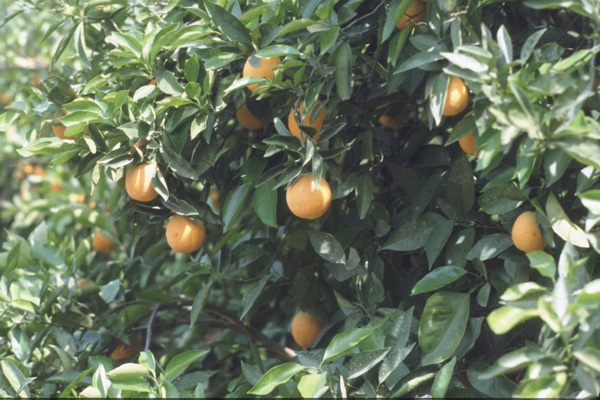February 10, 2012

A total of 14 citrus trees infected with citrus greening disease have been destroyed, leaving experts hopeful that the destructive plant disease can be contained.
Greening, or Huanglongbing, is a citrus plant disease that has no cure and eventually kills trees. Fruit from infected trees pose no health threat to humans, according to Dr. Mamoudou Setamou, an entomologist at the Texas A&M-Kingsville Citrus Center at Weslaco who facilitated the tree removal.
“It was important we take these trees out to remove the source of inoculum, the bacteria, and reduce the risk of the disease spreading,” Setamou said.
The destruction included the first Texas citrus tree confirmed earlier this month to be infected with greening which is spread from tree to tree by an insect vector, the Asian citrus psyllid (pronounced SILL-id), he said.
“The grove owner south of San Juan, who wishes to remain anonymous, agreed that the trees should be destroyed. He is very cooperative and very supportive of the area-wide psyllid control program,” Setamou said.
The Texas citrus industry is concentrated in two counties of the Lower Rio Grande Valley, covering some 28,000 acres and responsible for 4,000 jobs, according to the Texas Department of Agriculture.
“It’s that grower’s type of positive attitude, cooperation and teamwork that will help the Rio Grande Valley save its citrus industry from this devastating disease,” said Dr. Juan Anciso, a Texas AgriLife Extension Service fruit specialist in Weslaco.
Immediately after the first confirmation of citrus greening, an intensive insecticide spray program was implemented that included commercial groves and trees in nearby residential areas.
Earlier this week, five grapefruit trees in the grove were cut down, as well as nine orange trees in a nearby block, Setamou said.
“A few days before they were cut down, the trees were sprayed with an insecticide to knock out any psyllids that might have been on the trees,” he said. “The cut trees were piled in a heap and sprayed again to prevent any escape of psyllids or the arrival of new ones. The pile will be burned once the cut trees have dried out sufficiently.”
Harvest protocol
In another step to contain the disease, a fruit harvest protocol has been enacted for trees being harvested within the five-mile radius quarantine imposed by the Texas Department of Agriculture.
The object is to remove any plant material where psyllids reproduce and thrive, Setamou said.
“Trees must be treated with a pyrethroid one or two days before harvesting for a quick knockdown of any psyllid populations,” he said. “Then, after the fruit is handpicked, the harvesters take their fruit to a decontamination table in the orchard that is attached to a bin where any stems or leaves attached to the fruit are removed.”
Bins of fruit are then loaded onto flatbed trucks that must be covered with tarps while en route to a packing shed, he said. Upon arrival, the fruit is immediately washed with high-pressure water and brushes.
“There is also protocol for destroying any leaves they might find at the packing shed, and the bins need to be cleaned before they are reused,” he said.
Setamou said that despite the seriousness of citrus greening, which eventually kills citrus trees and has no cure, there is hope for optimism.
“Finding a new, devastating disease like this is never good news,” he said. “But we shouldn’t consider this as gloom and doom. It has the potential to wipe out large numbers of trees, but by working together I’m confident we can not only contain but reduce its impact here.”
Setamou said that unlike Florida, the Texas citrus industry was prepared for the arrival of greening and had taken proactive measures for years to reduce the populations of the insect that spreads the disease.
“Thanks to education and an area-wide management program by growers that was started three years ago, psyllid populations have declined dramatically,” he said. “In recent years we’ve found much lower psyllid populations in our commercial groves. The program has been successful beyond all expectations.”
Setamou is confident that now, more than ever, growers will continue their coordinated spray programs to keep the disease at bay.
“After every major disaster, society gets some type of boon, a benefit,” he said. “The event forces society to act, and in this case the major positive impact will be greater education and better care of citrus trees by both growers and the homeowners.”
You May Also Like




